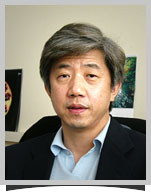1. Byun J, Yoon, J, Baek K. (2009) Ananlysis of two promoters that controls the expression o fthe GTP cyclohydrolase I gene in Drosophila melanogaster. Mol. Cell. 27:583-589.
2. Song M.-Y, Park S.-K, Kim C, Yoo T.H. Kim B, Kim M.-S, Kim Y.-S, Kwag W. J, Lee B.-K, Baek K. (2008) Characterization of a novel anti-human TNF-a murine monoclonal antibody with high binding affinity and neutralizing activity. Exp. Mol. Med. 40(1), 35-42.
3. Lee, S., Park, J., Lee, S., Park, J., Yu, S., Kim, H., Kim, D., Byun, T., Baek, K., Ahn, Y., and Yoon, J. (2008) Overproduction of recombinant human VEGF in Chinese hamster ovary cells. J. Microbiol. Biotechnol. 18(1), 183-187.
4. Lee, S., Leung, H-T., Kim, E., Jang, J., Lee, E., Baek, K., Pak, W., and Yoon, J. (2007) Effects of a mutation in the Drosophila porin gene encoding mitochondria voltage-dependent anion channel protein on phototransduction. Developmental Neurobiology 67, 1533-1545.
5. Kim, J. D., Yoon, Y., H.-Y. Hwang, Park, J. S., Yu, S., Lee, J., Baek, K., and Yoon, J. (2005) Efficient selection of stable Chinese hamster ovary cell (CHO) lines for expression of recombinant proteins by using human interferon b SAR element. Biotechnol. Prog. 21, 933-937.
6. Park, J., Yu, S., Yoon, J., and Baek, K. (2005) High-level expression of recombinant human Bone Morphogenetic Protein-4 in Chinese hamster ovary cells. J. Microbiol. Biotechnol. 15(6), 1397-1401.
7. Jin, J. S., Baek, S., Lee, H., Oh, M. Y., Koo, Y. E., Shim, M. S., Kwon, S. Y., Jeon, I., Park, S. Y., Baek, K., Yoo, M. A., Hatfield, D. L., and Lee, B. J. (2004) A DNA replication-ralated element downstream from the initiation site of Drosophila selenophosphate synthstase 2 gene is essential for its transcription. Nucleic Acids Research 32, 2482-2493.
8. Kim, J., Kim, J., Park, D., Kang, H., Yoon, J., Baek, K., and Yoon, Y. (2004) Improved recombinant gene expression in CHO cells using matrix attachment regions. J. Biotechnol. 107, 95-105.
9. Yoon, J. Leung, H., Lee, S., Geng, C., Kim, Y., Baek, K., and Pak, W. L. (2004) Specific molecular alterations in the norpA-encoded phospholipase C of Drosophila and their effects on electrophysiological response in vivo. J. Neurochem. 89, 998-1008.
10. Kim, E., Kim, D., Hwang, H-Y., Yoon, J., Yoon, Y., Baek, K. (2004) High-level expression of recombinant human interleukin-2 in Chinese Hamster Ovary cells using the expression system containing transcription terminator. J. Microbiol. Biotechnol. 14, 810-815.
11. Kim, D., Kim, J. D., Baek, K., Yoon, Y., and Yoon, J. (2003) Improved mammalian expression systems by manipulating transcriptional termination regions. Biotech. Prog. 19, 1620-1622.
12. Ryu, Y., Oh, Y., Yoon, J., Cho, W., and Baek, K. (2003) Molecular characterization of a gene encoding the Drosophila melanogaster phopholipase A2. BBA, 1628, 206-210.
13. Y. Hong, S. Park, C. Geng, K. Baek, J. D. Bowman, J. Yoon, and W. L. Pak. (2002) Single amino acid change in the fifth transmembrane segment of the TRP Ca+2 channel causes massive degeration of photoreceptors Journal of Biological Chemistry, 13 33884-33889.
14. J-W. Kim, V. Seghers, J-H Cho, Y. Kang, S. Kim, Y. Ryu, K. Baek, L. Aguilar-Bryan, Y-D. Lee, J, Bryan, and H. Suh-Kim. (2001) Transactivation of the mouse sulfonyurea receptor I gene by BETA2/NeuroD, Molecular Endocrinology 16(5), 1097-1107.
15. H. Park, C. Seong, J. Jang, J. Yoon, N. Cho and K. Baek, (2001) Promoter analysis of the Drosophila melanogaster gene encoding the pterin 4a-carbinolamine dehydrotase, Mol. Cells, 12 233-238
16. Oh, Y., Lee, S., Yoon, J., Han, K., and Baek, K. (2001) Promoter analysis of the Drosophila melanogaster gene encoding transcription elongation factor TFIIS. BBA 1518(3), 276-281.
17. US Patent (2008) US 7,422,874 B2, Expression vector for animal cell
18. US Patent (2007) US 7,259,010 B2, Expression vector for animal cell containing nuclear matrix attachment region of interferon beta
|






